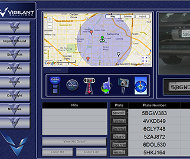License Plate Reader Technology Now Scans Occupants Faces
Police and private companies link facial recognition software to databases that track motorists. The leading suppler of automated license plate reader technology in the US (ALPR, also known as ANPR in Europe) is expanding its offerings to law enforcement. Vehicle owners have already had their movements tracked by the company Vigilant Solutions, which boasts 2 billion entries in its nationwide database, with 70 million additional license plate photographs being added each month. Now passengers can also be tracked if they hitch a ride with a friend and are photographed by a camera aimed at the front of the car. The Livermore, California-based firm recently announced expanded integration of facial recognition technology into its offerings.
The leading suppler of automated license plate reader technology in the US (ALPR, also known as ANPR in Europe) is expanding its offerings to law enforcement. Vehicle owners have already had their movements tracked by the company Vigilant Solutions, which boasts 2 billion entries in its nationwide database, with 70 million additional license plate photographs being added each month. Now passengers can also be tracked if they hitch a ride with a friend and are photographed by a camera aimed at the front of the car. The Livermore, California-based firm recently announced expanded integration of facial recognition technology into its offerings.
"The new Vigilant Mobile Companion app expands the benefits of license plate recognition and facial recognition technologies to all areas of the agency," a Vigilant Solutions press release claimed. "Using many of the new analytic tools that Vigilant has released in its Learn product over the last couple of years, the app makes these tools even more easy to use and accessible on a mobile device. The app also features Vigilant's Facesearch facial recognition which analyzes over 350 different vectors of the human face."
Though primarily intended for fixed security camera installations, the software could allow police to identify the occupants of vehicles when the system is supplied with a clear photograph of a car's interior. In states such as California and Arizona where red light cameras and speed cameras photograph the front of a car, the video stream can be analyzed in "near real time" to catalog and identify the driver and anyone in the passenger seat of passing vehicles, flagging any "person of interest."
The US District Court for the Eastern District of Virginia recently acknowledged the ability of standard ANPR systems to track a vehicle using the Vigilant Solutions online database that goes by the name National Vehicle Location Service, which has been fed with license plate images from law enforcement and private sources since 2008.
"A subsequent investigation revealed that a 2012 black Range Rover is registered to Eduard," the court wrote on December 17 in the case United States v. Loz. "A search of the National Vehicle Location Service's database also showed that this Range Rover had been spotted eight times near the closest intersection to Eduard's Forest Hills residence."
Only a handful of states have laws in place to regulate automated license plate reader technology.


0 reacties:
Post a Comment